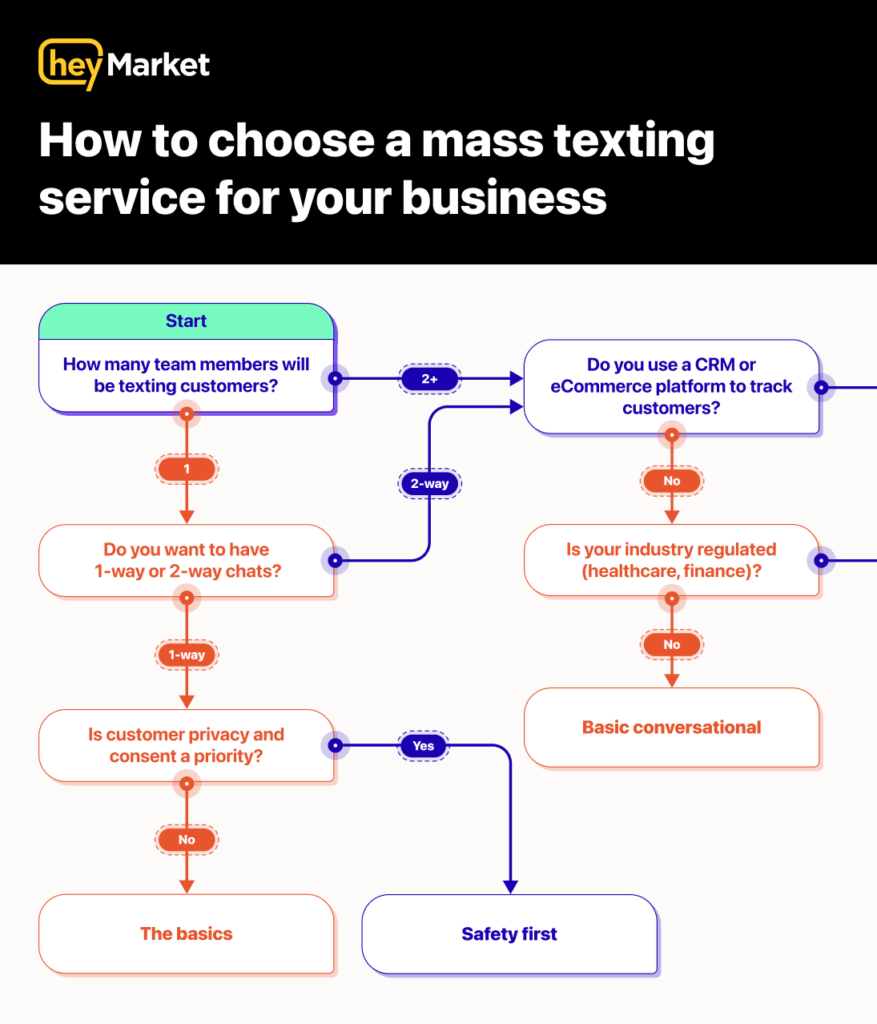
Mass texting—sending one text to multiple recipients—helps businesses directly connect with dozens or hundreds of customers and prospects efficiently. The strategy has grown popular with businesses in recent years because those on the receiving end of a mass text message are almost certain to read your message, since texts have a 98% open rate.
But there are a lot of business SMS services on the market, each offering different features that fit a wide variety of businesses and business needs. How can you find the best mass texting service for your business’s needs? What features should you be looking for?
In this article, we’ll walk you through the four most important features to consider while you’re searching for a mass texting service, and how to make sure they work for your business. (Plus, check out our flow chart for a visual guide to finding the right service.)
1. Mass Texting Basics
A mass texting service needs to have certain baseline features to even be considered to work for your business needs. You should make sure your service of choice offers:
- List broadcasts: It may seem like a no-brainer for a texting platform to be able to send messages to a list of customers, but not every service offers this feature. Make sure the platforms you’re considering allow you to send a single text message to a list of recipients. Research what list size the service allows you to send messages to per day. Small businesses should aim to be able to send to lists of at least 400 recipients per day, while larger companies should look for between 600-800 recipients. If that list size seems small to you, this actually could be a good thing; limiting the number of daily texts you send can help you avoid being flagged as spam (more on that later).
- Message templates. Text templates are a basic but crucial feature that allow you to write a message and save it for future use. You can apply this messaging template to future list sends. You can also edit and save it. You should be able to include photos and even videos in SMS templates. To send a bulk text, you choose an SMS template, select a list of recipients, then press send.
- Personalization features. More than 90% of consumers prefer interacting with brands that personalize their experience. Your texting service should allow you tailor texts to recipients at scale. Most tools let you create SMS templates and add merge tokens—custom fields from a customer’s profile such as name, order number, or loyalty status. Your platform should be able to dynamically insert this information when you send a text to a customer list.
- SMS drip campaigns. SMS drip campaigns help you send texts on a schedule. You can add customers to an SMS drip campaign list at any time, and they’ll start receiving the series of messages that you’ve created.
These tools provide the foundation of a good mass texting service. With their help, you can quickly send personalized messages to lists of customers.

2. Industry Regulation Support
Following your industry’s respective regulations is especially important when you’re sending texts to customers. Certain texting platforms offer more security or regulation-supportive features than others. Secure text messaging platforms can help you protect your data more thoroughly—and help you adhere to business text messaging’s regulations, too.
For example, your texting service should offer support for:
- The TCPA. The Telephone Consumer Protection Act (TCPA) protects customers from unwanted messages. Adhering to the TCPA ensures that you’re sending texts to people who want to be texted. Make sure your texting platform can automatically recognize opt-out keywords like STOPALL, so customers can opt out any time they want to stop receiving your texts.
- HIPAA. Health Insurance Portability and Accountability Act (HIPAA) protects sensitive patient data. If you work around the healthcare industry or use texting for healthcare purposes, it applies to you. Compliance isn’t simple, but if you have a texting platform that encrypts messages while they’re in transit, that can help you protect patient data.
- Avoiding carrier filtering. Any time you text a large list of customers, telecom carriers watch out for signs that the message could be spam. Your texting service can help you avoid being flagged as spam by limiting the number of texts you send per day. It may also provide best practices to improve your message deliverability.
Ultimately, the best mass texting service for you will help you cover all of your legal bases. That way, you can focus your attention on the most important thing: connecting with customers.
3. Connecting Your Data
If your team relies on business apps, like CRM or eCommerce platforms, your texting service should offer integrations with other apps. With help from an integration, you can share data and even text from those platforms. Having an interconnected business app ecosystem helps you personalize texts even when you send them to multiple customers at once. It can also help you manage customer replies efficiently.
Take stock of the systems you use daily, and look for texting services that integrate with:
- CRM systems. Whether you use Salesforce, HubSpot, or another platform, your CRM system is the center of truth for your customer data. You need to be able to integrate your CRM with your texting service so you can build customer lists and send mass texts to them right from your CRM interface.
- Internal chat apps. Live in Slack or Microsoft Teams? You don’t have to leave your platform of choice ever again with help from an SMS integration. You can send texts to customers (and reply to their responses) from within either interface, improving team collaboration and productivity.
- eCommerce platforms. eCommerce platforms, like Shopify, are critical to keeping customer orders organized. Customer communication is a critical part of the ordering experience, too. You can manage it all in one place with a Shopify SMS integration, making sure customers are always on top of their order’s (or return’s) latest movements.
- APIs. Some businesses rely on a customized or homegrown tool. This is especially the case in regulated industries like healthcare or finance. If this situation applies to you, see if the text service offers APIs that can connect your SMS platform to your unique systems and share data.
- CSV imports. For some businesses (usually those that are regulated), a CSV import may be a better choice for syncing data. The process can be more straightforward and help you remain compliant with industry regulations. If your regulated business needs to upload contacts to your texting platform, make sure the service offers CSV imports.
The best texting service for you will integrate with your favorite business apps and internal tools. With an interconnected business app ecosystem, your team can easily send and manage texts—and keep all of the respective messaging data organized.
4. Two-Way Messaging
At their core, mass texting services focus on sending outbound texts to multiple recipients. But your business may need to do more than send one-way texts. In many cases, you may want customers to be able to reply to you and engage with your team. The following features allow you to have conversations with customers and make that process more efficient for your team:
- Two-way messaging: If you want customers to be able to respond to your texts, make sure your texting service enables two-way messaging. This feature allows customers to reply to your text just as they would reply to a normal text from a friend—by responding to the same number and carrying on the conversation uninterrupted.
- A shared inbox. If you want customers to respond to your texts, a shared inbox lets you organize all incoming customer messages in one place. That way, all of your team members can see customer replies to your texts. This kind of transparency prevents messages from slipping through the cracks.
- Collaboration tools. If you expect a high volume of inbound messages, some services offer tools that help your team work together on text conversations, streamlining their workload and providing faster replies. Assignments allow managers or team members to assign text messages to one another. Private comments allow team members to ask questions and share information internally, in-line with the texting thread.
- Automations. Automations take over simple tasks for you. For example, you can set up auto replies so customers who reply to your texts after hours know when they’ll receive responses.
Two-way messaging is essential for brands that need to allow customers to respond to their texts. These team-based features will make it easier to streamline responses.
Conclusion: Finding the Best Mass Texting Service for Your Business
Every business has different needs, and yours is no different. The key to finding the best mass texting service for your business is understanding your requirements and finding the platform that meets each of them. With so many mass texting services on the market, you’ll be sure to find one that’s just right for you.
The four categories explored in this article will help you examine the most important factors in a texting service. You absolutely need basic texting features, which empower you to send texts easily. Depending on your industry and needs, you may also need features that help you achieve compliance with industry regulations, connect your texting platforms with the tools you use every day, and have two-way customer conversations.
Ultimately, this guide—and the accompanying flow chart—will help you pick the perfect service for you, streamlining your customer communications and helping you create a seamless customer experience.




